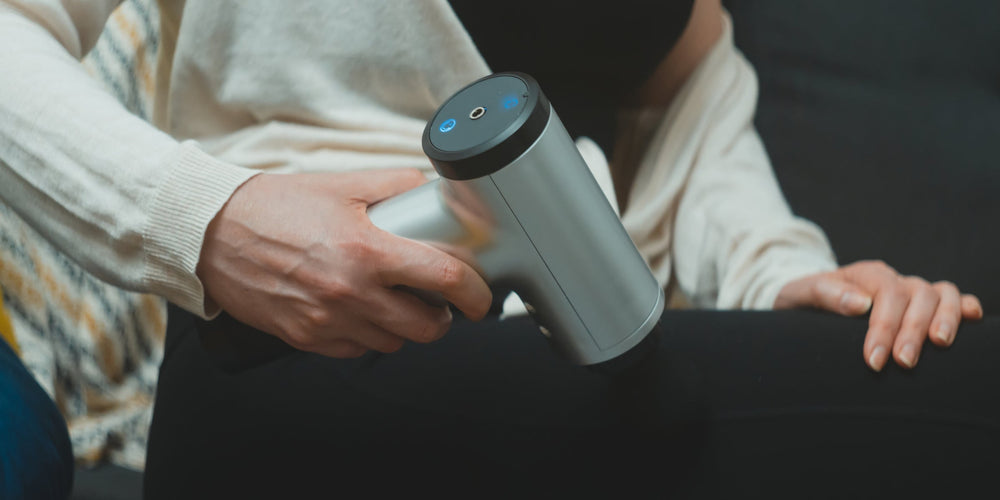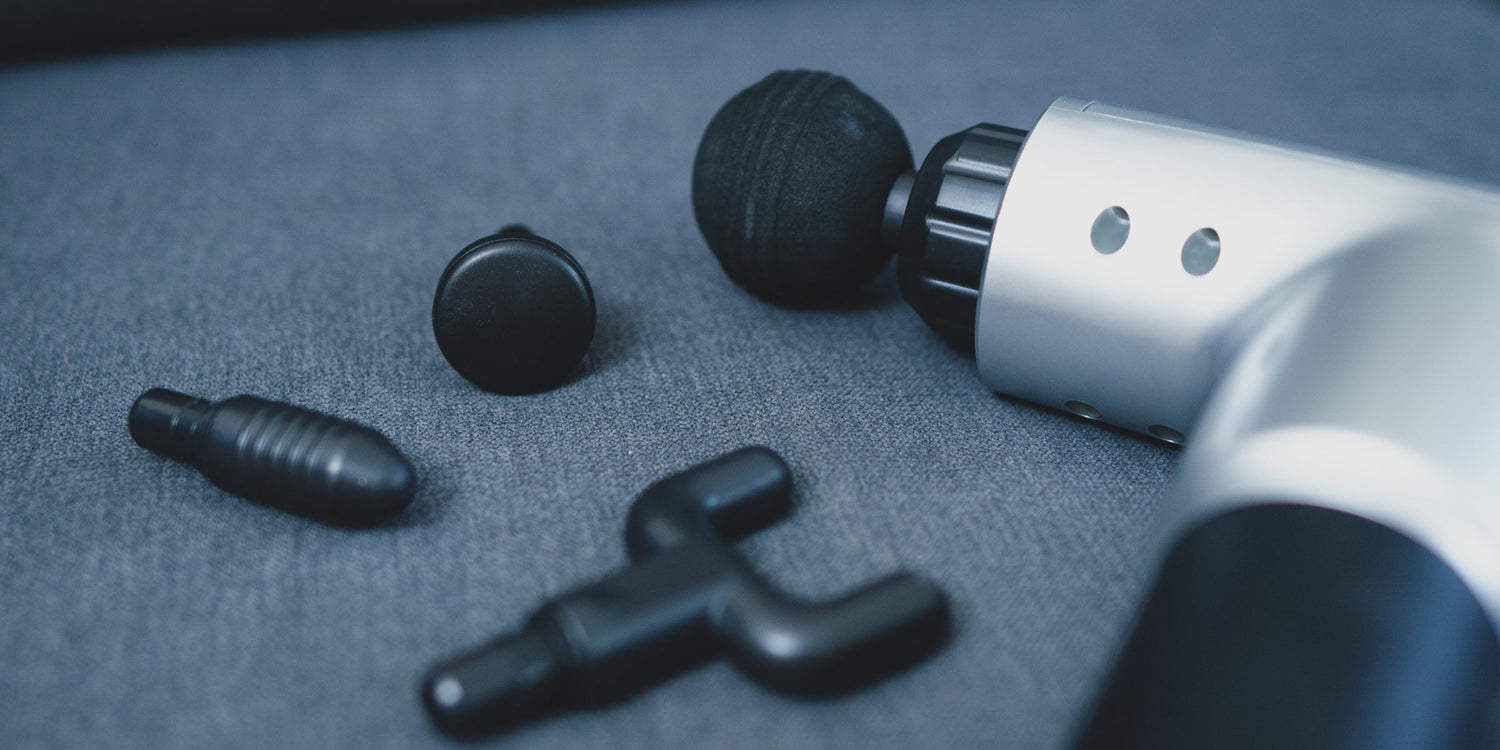Unlocking the Secrets of Massage Guns for Effective Knee Pain Management

Stay tuned to our latest news
Knee pain, a debilitating condition affecting people of all ages and lifestyles, can stem from various causes such as injury, arthritis, or overuse. Finding relief is essential for maintaining an active and fulfilling life. While traditional methods such as rest, ice, and medication have their place, massage guns offer a unique approach that targets the root cause of the pain.
Massage guns, also known as percussion massagers, are handheld devices that utilize rapid and repetitive movements to provide deep tissue massage. With their adjustable intensity levels and various attachments, these portable powerhouses can deliver targeted therapy to the muscles surrounding the knee joint, promoting circulation, reducing inflammation, and alleviating pain. But what sets massage guns apart from other methods? How do they work, and why are they so effective for knee pain management?
So, without further ado, get ready to discover a new level of relief for knee pain and regain control over your daily activities.
Why Is Knee Pain Management Important?

Knee pain management is crucial for athletes as chronic muscle pain can significantly impact their performance. Athletes rely heavily on their knees for mobility and stability during physical activities such as running, jumping, and pivoting. The presence of knee pain can severely hinder their ability to perform at their best, leading to decreased athletic performance.
Trigger point therapy has proven to be an effective method for managing knee pain symptoms. This therapy involves applying pressure to trigger points, which are tight knots of muscles that cause pain and discomfort. By releasing these trigger points, athletes can experience pain relief, improved range of motion, and enhanced muscular function. Trigger point therapy has been recognized as a valuable tool in managing muscle pain associated with knee injuries and conditions like patellofemoral pain syndrome or IT band syndrome.
Addressing knee pain not only contributes to improved athletic performance but also supports overall well-being. Athletes who manage their knee pain effectively are more likely to maintain their physical fitness and continue their sporting activities without limitations. They can avoid potential complications such as worsening of the injury or overcompensation by other parts of the body, which may lead to additional muscle imbalances and injuries. By addressing knee pain, athletes can experience enhanced movement, reduced discomfort, and an overall better quality of life.
What Is Knee Pain?

Knee pain is a prevalent condition that affects individuals of all age groups. It manifests as discomfort or soreness in or around the knee joint. Knee pain can vary in intensity and may be accompanied by other symptoms such as swelling, stiffness, or limited range of motion. It can be caused by various factors including injuries, overuse, age-related wear and tear, or underlying medical conditions such as arthritis. Knee pain can significantly affect mobility and daily activities, making it important to seek proper diagnosis and treatment to manage the pain effectively and maintain optimal knee health.
What Causes Knee Pain?
Knee pain is a common condition that can have various underlying causes. Some of the common causes include osteoarthritis, ligament injuries, meniscus tears, bursitis, and patellar tendinitis.
Osteoarthritis is one of the leading causes of knee pain, particularly in older adults. It occurs when the protective cartilage that cushions the ends of the bones in the knee joint begins to wear down, resulting in bone-on-bone friction. This causes pain, swelling, stiffness, and restricted movement.
Ligament injuries, such as an anterior cruciate ligament (ACL) tear or a medial collateral ligament (MCL) sprain, can also trigger knee pain. These injuries often occur during sports or physical activities and are characterized by sudden and severe pain, swelling, and instability. Ligament injuries can severely impede knee function and mobility.
Meniscus tears are another common cause of knee pain. The meniscus is a rubbery, C-shaped disc that cushions the knee joint. Tears typically occur due to rotational force or degenerative changes, causing pain, swelling, stiffness, and difficulty bending or straightening the knee.
Bursitis refers to the inflammation of the bursae, small fluid-filled sacs that cushion the knee joints. It often results from repetitive kneeling or overuse, leading to pain, tenderness, swelling, and warmth around the knee.
Patellar tendinitis, also known as jumper's knee, is an overuse injury that affects the patellar tendon connecting the kneecap to the shin bone. It commonly occurs in athletes who engage in repetitive jumping or kicking motions. Symptoms include pain, swelling, and tenderness around the knee joint.
How Can Massage Guns Help Manage Knee Pain?

Massage guns are highly effective in managing knee pain by targeting the muscles and soft tissues surrounding the knee joint. They achieve this through various mechanisms.
Firstly, massage guns increase circulation by delivering rapid pulses of pressure to the affected area. This promotes blood flow, which helps deliver oxygen and nutrients while removing waste products, reducing inflammation, and relieving muscle tension.
Secondly, massage guns provide deep tissue massage, reaching deep into the muscle fibers to release tension and knots. By relaxing the muscles, they alleviate stress on the knee joint and reduce pain.
Additionally, massage guns can target myofascial tissue, which surrounds and supports the muscles. By breaking up adhesions and releasing tension in the fascia, they improve mobility, reduce pain, and enhance overall function.
Massage guns also stimulate sensory receptors in the skin and muscles, disrupting the transmission of pain signals to the brain through the pain gate theory. This provides temporary relief from knee pain and promotes a sense of well-being.
Lastly, massage guns with specific attachments can be used for trigger point therapy, targeting areas of increased sensitivity or tightness around the knee. By applying focused pressure, they help release trigger points and provide localized relief.
However, it's important to use massage guns in conjunction with other treatments and under the guidance of a healthcare professional. Following proper usage techniques, starting with lower intensity levels, and avoiding direct pressure on the knee joint are crucial.
Incorporating massage guns into a knee pain management routine can offer targeted relief, improved circulation, muscle relaxation, and enhanced mobility. However, consulting with a healthcare professional is always the recommended first step to determine the most appropriate approach for individual conditions.
How to Use a Massage Gun Effectively for Knee Pain?
Suffering from knee pain can severely limit our ability to carry out daily activities and diminish our overall quality of life. One effective way to alleviate this discomfort is by using a massage gun. This powerful tool can target sore or stiff muscle groups in the knee area, providing relief and promoting healing. However, it is essential to use the massage gun correctly to ensure optimal results and prevent any further injury.
Before starting the massage, it is important to examine the knee area for any cuts or bruises. Massaging over an open wound can exacerbate the injury and lead to infection. Once you have confirmed that the knee is clear of any external damage, you are ready to begin.
To effectively use a massage gun for knee pain, it is crucial to select the appropriate attachment. The ball head attachment is commonly used in this case, as it provides a wider surface area for targeted relief. Hold the massager perpendicular to the muscles surrounding the knee joint and apply gentle pressure. Start by massaging in circular motions, gradually increasing the intensity as your muscles loosen up.
Remember to maintain consistent movement and avoid lingering in one spot for too long. This ensures that the entire muscle group receives the necessary attention. It is also vital to listen to your body and adjust the pressure accordingly. If you experience pain or discomfort, reduce the intensity or choose a softer attachment.
How Are Massage Guns Compared to Traditional Massage Techniques When It Comes to Knee Pain?
Massage guns have gained popularity in recent years as a convenient alternative to traditional massage techniques for addressing knee pain. They offer several advantages over traditional massage in terms of convenience and effectiveness. Firstly, massage guns are portable and easy to use, allowing individuals to target specific areas of knee pain at their convenience, without the need for a professional masseuse. This makes them a cost-effective option for individuals who experience regular knee pain.
Another advantage of these devices, or vibration guns, is their ability to promote blood flow and aid muscle recovery. The high-frequency vibrations generated by massage guns can stimulate blood circulation in the affected areas, improving oxygen and nutrient supply to the tissues. This increased blood flow can help reduce inflammation and swelling, providing relief from pain and promoting faster healing. Additionally, massage guns can help alleviate muscle tightness and stiffness, enhancing flexibility and range of motion in the knee joint.
Despite these benefits, massage guns also have certain limitations and risks. One limitation is that they may not be suitable for individuals with certain underlying conditions such as arthritis, fractures, or joint instability. Moreover, if used incorrectly or in highly sensitive areas, massage guns can cause bruising, tissue damage, or exacerbate pain.
Takeaway
Knee pain can be a debilitating condition that affects people of all ages and lifestyles. While traditional methods such as rest, ice, and medication have their place, massage guns offer a unique approach that targets the root cause of the pain. With their ability to increase circulation, provide deep tissue massage, target myofascial tissue, stimulate sensory receptors, and offer trigger point therapy, massage guns can effectively manage knee pain.
It is important to use massage guns in conjunction with other treatments and under the guidance of a healthcare professional. Proper usage techniques, starting with lower intensity levels, and avoiding direct pressure on the knee joint are crucial. Incorporating massage guns into a knee pain management routine can offer targeted relief, improved circulation, muscle relaxation, and enhanced mobility.
However, it is always recommended to consult with a healthcare professional to determine the most appropriate approach for individual conditions. By using massage guns effectively and responsibly, individuals can find relief from knee pain and regain control over their daily activities.
Renpho Health Tips
-

From Discomfort to Comfort: Managing Chronic Pain with Therapy Guns
April 23, 2024
Read more >
-

The Beauty of a Measured Stride: Balancing Ambition with Well-being
April 18, 2024
Read more >
-

Conquering Cash Concerns: A Guide to Overcoming Financial Anxiety
April 17, 2024
Read more >
-

Circulation Hacks 101: 5 Solutions to Improve Blood Flow in a Sedentary Lifestyle
April 15, 2024
Read more >
-

Creative Outlets: Using Art to Express and Relieve Stress
April 14, 2024
Read more >






